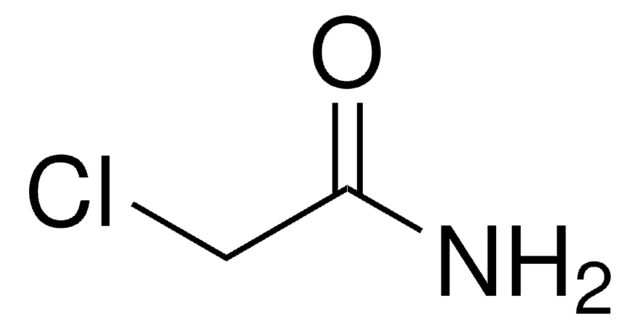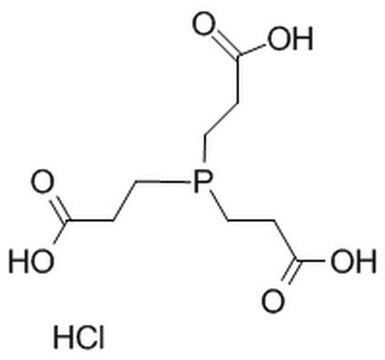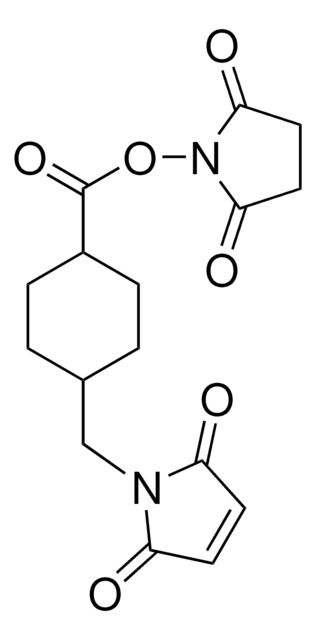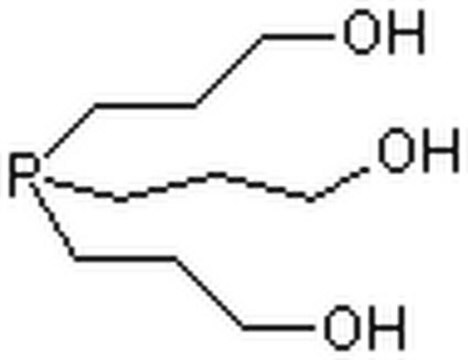68957
Tris(2-carbossietil)fosfina
BioUltra, suitable for electrophoresis, SDS-PAGE tested
Sinonimo/i:
TCEP
Autenticatiper visualizzare i prezzi riservati alla tua organizzazione & contrattuali
About This Item
Formula empirica (notazione di Hill):
C9H15O6P · HCl
Numero CAS:
Peso molecolare:
286.65
Beilstein:
3724376
Numero MDL:
Codice UNSPSC:
12352128
ID PubChem:
NACRES:
NA.32
Prodotti consigliati
Nome Commerciale
BioUltra
Saggio
97.5-102.5%
Stato
powder
tecniche
electrophoresis: suitable
Solubilità
H2O: soluble
Compatibilità
SDS-PAGE tested
Stringa SMILE
Cl[H].OC(=O)CCP(CCC(O)=O)CCC(O)=O
InChI
1S/C9H15O6P.ClH/c10-7(11)1-4-16(5-2-8(12)13)6-3-9(14)15;/h1-6H2,(H,10,11)(H,12,13)(H,14,15);1H
PBVAJRFEEOIAGW-UHFFFAOYSA-N
Cerchi prodotti simili? Visita Guida al confronto tra prodotti
Descrizione generale
Tris(2-carboxyethyl) phosphine hydrochloride (TCEP.HCL ) is a useful reducing agent for Sulphur and nitrogen-containing compounds. TCEP.HCL and the resultant oxide are water-soluble. TCEP.HCL has electron-rich phosphorus and oxygen atoms to combine with various metals, including Rh, Ir, and Pd. It rapidly complexes with Rh and Ir in dioxane at ambient temperature. It reduces disulfide linkages in a range of peptides and proteins in biological disulfide.
Applicazioni
Reagente solubile in acqua, utilizzato per la riduzione selettiva dei disolfuri. Più stabile del DTT, viene utilizzato in applicazioni di spettrometria di massa.
TCEP.HCL has been used in various bioconjugation applications, both in vitro and in vivo, to tag proteins and live organisms with great effectiveness under mild physiological circumstances. TCEP.HCL is suitable for varied biological and synthetic applications. At an acidic pH, TCEP.HCL can be used to convert organic disulfides to thiols in water irreversibly.
Caratteristiche e vantaggi
The product has the following benefits:
- TCEP.HCL lowers reactive oxygen species levels.
- It increases glutathione levels and mitochondrial content.
- It has anti-cancer effects.
Risultati analitici
agarose gel electrophorese corresponds to requirements
Avvertenze
Danger
Indicazioni di pericolo
Classi di pericolo
Eye Dam. 1 - Skin Corr. 1B
Codice della classe di stoccaggio
8A - Combustible corrosive hazardous materials
Classe di pericolosità dell'acqua (WGK)
WGK 1
Scegli una delle versioni più recenti:
Possiedi già questo prodotto?
I documenti relativi ai prodotti acquistati recentemente sono disponibili nell’Archivio dei documenti.
I clienti hanno visto anche
Siming Chen et al.
Chemical communications (Cambridge, England), 49(12), 1226-1228 (2013-01-05)
A widely used reducing agent tris-(2-carboxyethyl) phosphine significantly promotes the reaction of cisplatin with Sp1 zinc finger protein. This discovery clarifies the reactivity of cisplatin towards Sp1 zinc finger protein and implies that the reactions of platinum drugs could be
Fang-Fang Cheng et al.
The Analyst, 139(16), 3860-3865 (2014-07-01)
The expression of microRNAs (miRNAs) is related to some cancer diseases. Recently, miRNAs have emerged as new candidate diagnostic and prognostic biomarkers for detecting a wide variety of cancers. Due to low levels, short sequences and high sequence homology among
Yan Li et al.
Biosensors & bioelectronics, 67, 364-369 (2014-09-10)
The development of sensitive telomerase biosensors is hindered by the restricted accessibility of telomere strand (TS) primer and the limited enzyme reaction space, which is mainly confined by the vertical distance. In this work, we designed an electrochemical telomerase biosensor
K Zarschler et al.
Nanoscale, 6(11), 6046-6056 (2014-04-30)
For effective localization of functionalized nanoparticles at diseased tissues such as solid tumours or metastases through biorecognition, appropriate targeting vectors directed against selected tumour biomarkers are a key prerequisite. The diversity of such vector molecules ranges from proteins, including antibodies
Nicola J Blackmore et al.
The Journal of biological chemistry, 290(29), 18187-18198 (2015-06-03)
Allostery, where remote ligand binding alters protein function, is essential for the control of metabolism. Here, we have identified a highly sophisticated allosteric response that allows complex control of the pathway for aromatic amino acid biosynthesis in the pathogen Mycobacterium
Il team dei nostri ricercatori vanta grande esperienza in tutte le aree della ricerca quali Life Science, scienza dei materiali, sintesi chimica, cromatografia, discipline analitiche, ecc..
Contatta l'Assistenza Tecnica.









